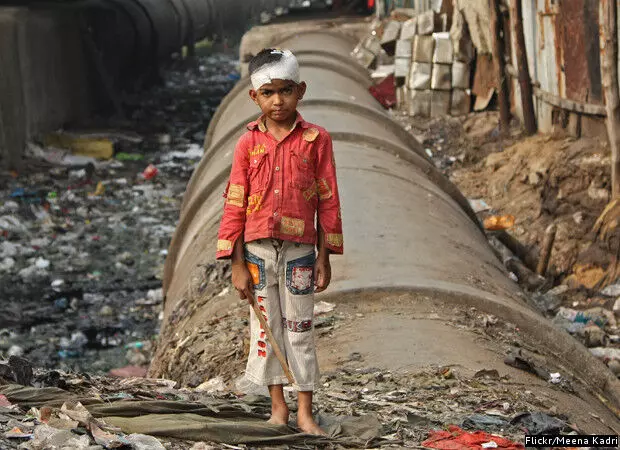Shut Out: India's Poor, Urban Children—Part I

- Child labour in India's urban areas increased 53% over the decade between 2001 and 2011. In the age group five-to-nine years, the number of girls put to work increased 240%, boys 154%.
- Urban India has 0.2 million elementary schools, against 1.2 million in rural areas; urban schools serving the poor are more crowded than rural schools and their learning outcomes as dismal.
In the second of a two-part series on poor, urban children, IndiaSpend explores education, child labour and crime. You can read the first part here. Attention was recently focused on the state of poor, urban children after a report by PricewaterhouseCoopers (PwC) and Save The Children.
India's rapidly-growing urban areas have better education facilities than rural areas, but these are unequally distributed.
Schools serving the urban poor have an average of 229 students, against 118 in rural areas, the PwC-Save The Children report said. A school building working double-shift to accommodate more children is seen more often in urban areas (11%) than in rural ones (2%), and urban schools for the poor have a higher dropout rate.
| Primary to Upper Primary: The Great Fall 2013-14 (Urban Retention Rate) | |||
|---|---|---|---|
| Classes | Boys | Girls | Total |
| Class I-V | 13.6 | 12.4 | 26 |
| Class VI-VII | 6.9 | 6.3 | 13.3 |
Source: District Information System for Education, 2013-14, (Figures in million)
The table shows that the number of children who move from primary to upper-primary school comes down by almost half in urban areas. Migration is one of the major reasons for kids leaving school. Since parents keep moving, children have to move with them.
“It seems that the existing number of schools is insufficient to accommodate all children in urban schools and its impacts are obvious on enrolment and retention of children in the school,” said the PwC-Save-The-Children report.
Learning outcomes as dismal for urban poor as rural
The government-school student—overwhelmingly from a poor family—in an urban area is dogged by the same, dismal learning outcome as the disadvantaged in a rural area.
About 45% of students in standards three to five in Delhi government schools could not read a standard one text, according to a 2013 Annual Status of Education (ASER) report, against 20% who could not in private schools.
Similarly, 24% of government school children in standards three to five could do subtraction, compared with 56% of private-school students, the report said. Similar outcomes were evident in ASER studies in Jaipur, Hyderabad, Mysore and Patna.
| Slower To Learn At State Schools | ||||
|---|---|---|---|---|
| Cities | Could read Std 1 text (govt schools) | Could read Std 1 text (pvt schools) | Could do simple subtraction (govt schools) | Could do simple subtraction (govt schools) |
| Delhi | 55% | 80% | 24% | 56% |
| Jaipur | 59% | 77% | 36% | 46% |
| Hyderabad | 34% | 40% | 38% | 41% |
| Mysore | 49% | 53% | 49% | 73% |
| Patna | 65% | 83% | 56% | 75% |
Source: Annual Status of Education, 2013
The (real) employment growth spurt: Children aged five to nine
Overall, child labour is decreasing in India at a rate of 2.2%—at this rate it will take a century to stop child labour, said a 2012 study done by Child Rights and You (CRY), an advocacy.
Even this slowdown isn't evident in urban areas.
Child labour in urban India increased 53% between the decade 2001-2011, said the CRY report, analysing census data. But the biggest employment spurt over the period was witnessed in the age group five-to-nine years: the number of working girls grew 240%, boys 154%.
The reasons were likely to be migration, including seasonal migration, and increased child trafficking, the report said.
As the first part of this series pointed out, as distress grows in rural India (home to 833 million people), India's urban areas are witnessing a population explosion. The urban population added 91 million people—more than the populations of Germany or Egypt—in the decade that ended in 2011 and grew 2.5 times faster than in rural areas. Many more children are available for work and exploitation.
Prospering urban India traps girls from poor, rural states
Most Indian families have maids, and with growing urban prosperity, the demand is rising. "This has resulted in trafficking of girls from villages in West Bengal, Jharkhand and Chattisgarh to live under extremely poor conditions, first in 'placement agencies' and later in the employer's home," said this Childline report on trafficking.
The urban-rural divide has particularly put pre-teen girls at trafficking risk, both for domestic work, child labour and sex work.
"Both low levels and high levels of economic development can encourage trafficking, implying that states can transition from being sources to destinations as they develop economically," said this 2010 Stanford University report for the Asia Foundation. ■
Of 377 million Indians, 32% are children below 18 years of age, and more than eight million children under six years live in approximately 49,000 slums, according to the PwC report, which quotes census data.
There are many more than these who live in poverty but are not counted as officially poor because they may live on more than Rs 47 per day. Between 15 and 18 million children lived in slums, according to UNICEF, in 1992. Clearly, poor, urban children are under-counted.
The 49,000 slums the report refers to are those that are officially counted and recognised, or "notified". There are thousands more uncounted slums with unknown numbers of children. There are 13.7 million slum households, according to Census 2011.
You can read the first part of this series here.
(Salve and Tewari are policy analysts at IndiaSpend.)
__________________________________________________________________“Liked this story? IndiaSpend.com is a non-profit, and we depend on readers like you to drive our public-interest journalism efforts. Donate Rs 500; Rs 1,000, Rs 2,000.”



